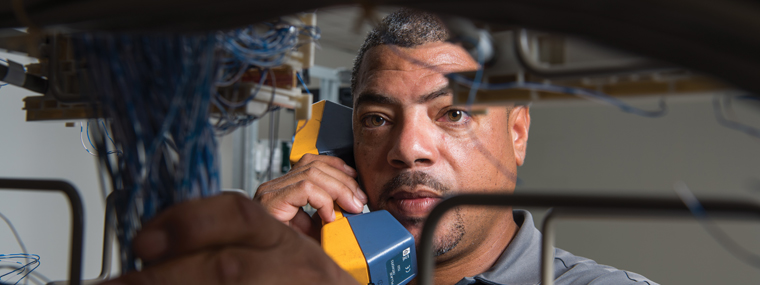
Increased Benefits at a Reduced Cost
By Jennifer Burks / Published November 2020

In the best economies, budget season tests a community manager’s ability to reduce waste and effectively forecast in a changing environment. During a global pandemic, that test becomes a matter of survival, and now more than ever community managers and their boards are looking for ways to become more efficient.
We know that elevator phones and their monitoring aren’t at the top of the list when looking for cost savings, but we also know how much an elevator phone can cost you (which you can read about at www.kingsiii.com/help-phone-blog/do-you-know-how-much-your-elevator-phone-costs-you/). You are required by code to have an emergency elevator phone that is monitored 24/7/365 by authorized personnel. Typically, though, it’s not the monitoring that costs you (and trust us, you’re getting what you pay for there). It’s the telephone line that’s the real expense and an often-overlooked line item because it’s lumped into a single bill with your other telephone costs. Do you know what you’re getting for the money you are spending? What if you could reduce your costs while mitigating risk and liability and also better manage the experience?
When we meet with a prospective customer, one of the first questions we ask is, what are their current phone costs? Most often they don’t know exactly how much they are paying, and when compared to Kings III’s solution, they are quite surprised by the results—not only how much lower their emergency phone expense could be but specifically just how much of their bill was attributed to local fees. Let’s look at two scenarios.
The first example is in Boca Raton, Florida. This community has two elevators and had two dedicated phone lines with a total cost of more than $300 per month. One line was under contract and billed at more than $80 per month. The other line was not under contract and cost more than $200 per month. Both lines included additional unnecessary charges–in particular, a long-distance plan. With the proposed solution, the community was able to cut by one-third that $300 monthly bill.
 In another example, a Washington, D.C., community is paying their current provider more than $100 a month per line, but most of that cost is not for the phone line. Let’s take a look. In the following bill, to the left, you will see the base cost per line is only $39.45.
In another example, a Washington, D.C., community is paying their current provider more than $100 a month per line, but most of that cost is not for the phone line. Let’s take a look. In the following bill, to the left, you will see the base cost per line is only $39.45.
That seems reasonable; however, when you add in local taxes and surcharges as well as regulatory fees, the cost per line more than doubles. The total phone bill is for 13 lines, so when averaged, that’s an additional $73 per line. See the summary below:
Taxes and Surcharges $378.77
Regulatory Fees + $569.91
= $948.68
$948.68 ÷ 13 = $73 per line
 The chart to the left shows the breakdown of the taxes, surcharges, and regulatory fees:
The chart to the left shows the breakdown of the taxes, surcharges, and regulatory fees:
Benjamin Franklin is famously quoted as saying, “But in this world nothing can be said to be certain, except death and taxes,” and that certainly seems to be the case here. But it doesn’t have to be.
Now let’s look at Kings III’s solution. There are eight elevator phones and one pool phone, so we would be able to replace nine of those 13 phone lines (because the company only monitors emergency phones). The monthly monitoring fee per line for this property is just under $44, or $395 for all nine phones. This would reduce the bill by $662.88 a month. That’s an almost $8,000 a year savings (less the upfront connection fee investment of $3,005). This still saves approximately $5,000 in the first year and the full $8,000 annually in subsequent years!
So, what’s the difference between the standard option and the $0 down option? The standard option includes a one-time upfront connection fee. For those customers looking to avoid an upfront expense, the $0 down option is $512 a month and still results in an annual savings greater than $6,500. And as a customer with a master service agreement, you could save even more with discounted volume pricing.
 On the left is a comparison of current costs to Kings III’s options:
On the left is a comparison of current costs to Kings III’s options:
That seems pretty straight forward, but let’s not forget all the other benefits you receive. Services are full turnkey. Equipment, installation, monitoring, and lifetime maintenance are included. The cost of a replacement elevator phone alone will often run $1,000 or more and is always an unbudgeted expense. An excellent service provider increases safety and reliability, helps mitigate risk and liability exposure, and, very importantly, allows you to better manage your resident experience.
How can we do so much more for so much less? For starters, we’re not a telecom company, and so, we are not subject to these same taxes and fees. Additionally, smart line seizure technology allows your elevator phone (or other emergency phone) to connect to an existing non-essential phone line, eliminating the need for dedicated lines. And when our operators are on the line, you know the call is being answered in a consistent manner by a highly trained emergency dispatch operator.
 Increased benefits at a reduced cost? I think that’s what you call a “no-brainer.” Go ahead and dig out your current phone bill for comparison. We are happy to help walk you through the comparison process against current costs, whether in Boca Raton, Washington, D.C., or your local market.
Increased benefits at a reduced cost? I think that’s what you call a “no-brainer.” Go ahead and dig out your current phone bill for comparison. We are happy to help walk you through the comparison process against current costs, whether in Boca Raton, Washington, D.C., or your local market.
Jennifer Burks
Kings III Emergency Communications
Jennifer Burks works with Kings III Emergency Communications and when not producing sales and marketing content she spends most of her time launching new markets. For more information on Kings III Emergency Communications, call (833) 807-2890 or visit kingsiii.com.





